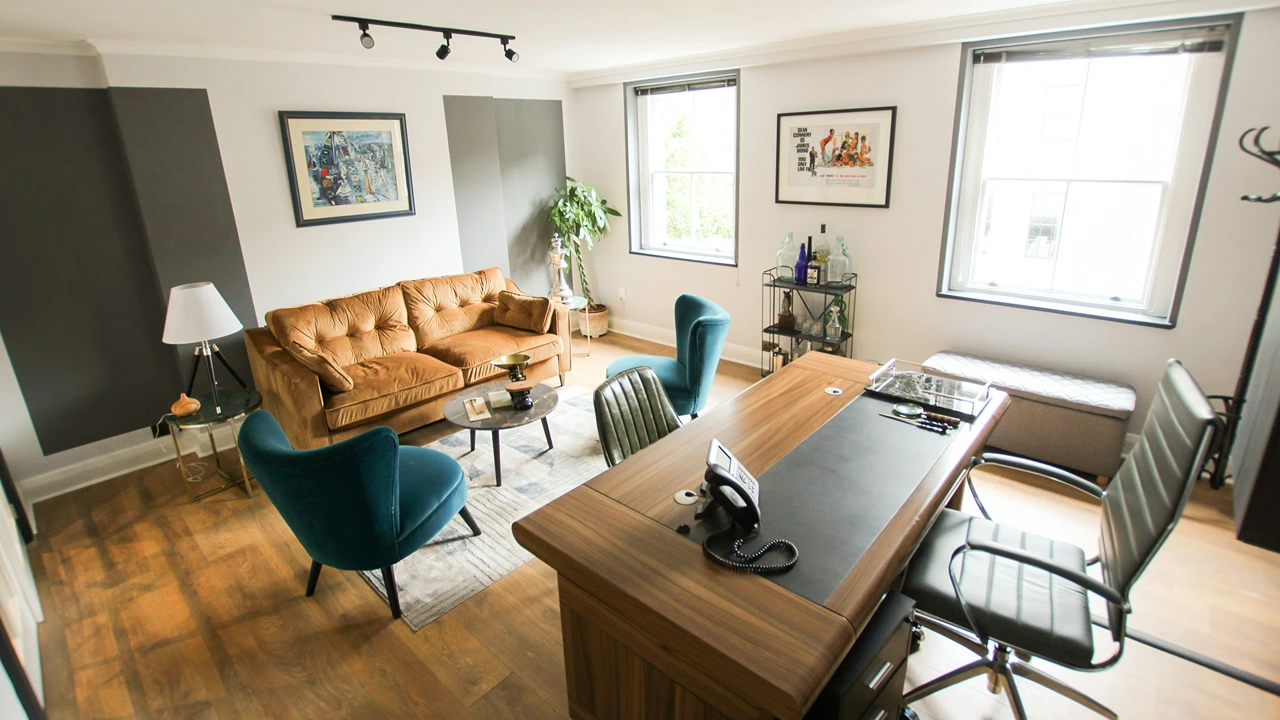Is your workspace inspiring productivity or stifling it? Whether you’re working from home or sprucing up your office, your surroundings play a huge role in your focus, creativity, and motivation. A well-designed office isn’t just about aesthetics—it’s about creating an environment that fuels efficiency and keeps you in the zone.
In this post, we’ll explore how thoughtful office interior design can transform your home office space into a haven for creativity and productivity, and share office ideas that you can easily implement to elevate and design a productive and stylish office space, tailored to your unique needs.
Why is a Well-Designed Office Important?
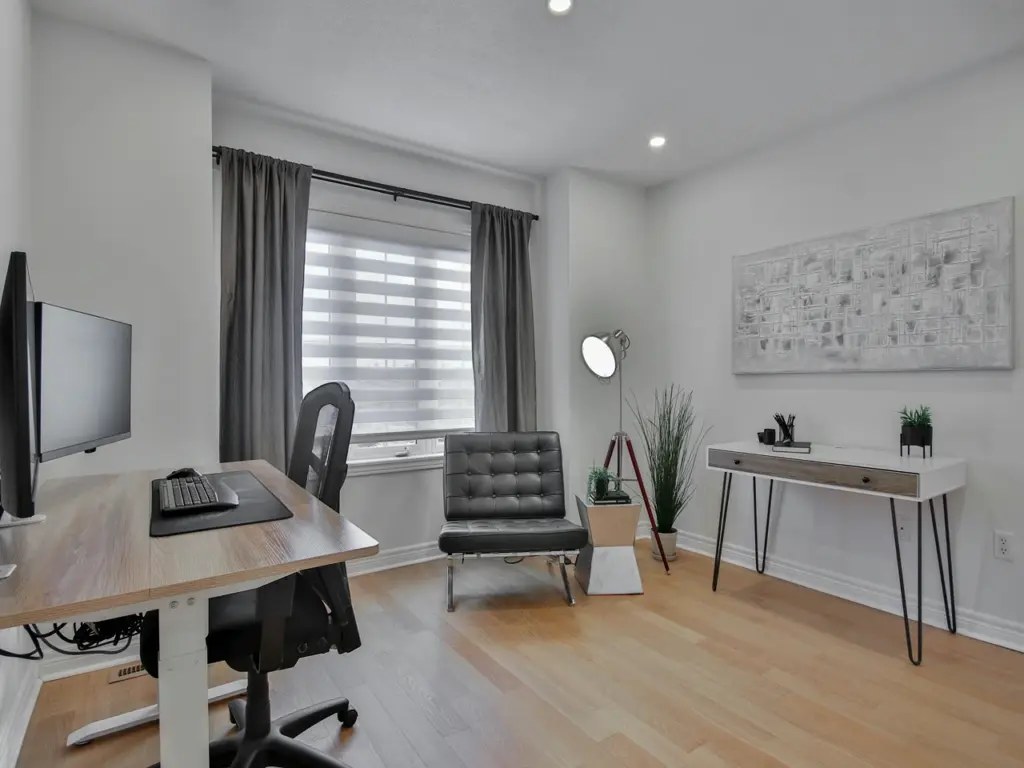
A carefully planned office promotes focus, comfort, and efficiency. Well-designed office promotes better mood and productivity, helping you stay focused and productive. By combining chic furnishings, natural accents, and practical solutions, your workspace can become an environment that inspires innovation while supporting your way of working.
Creating the Perfect Home Office Workspace
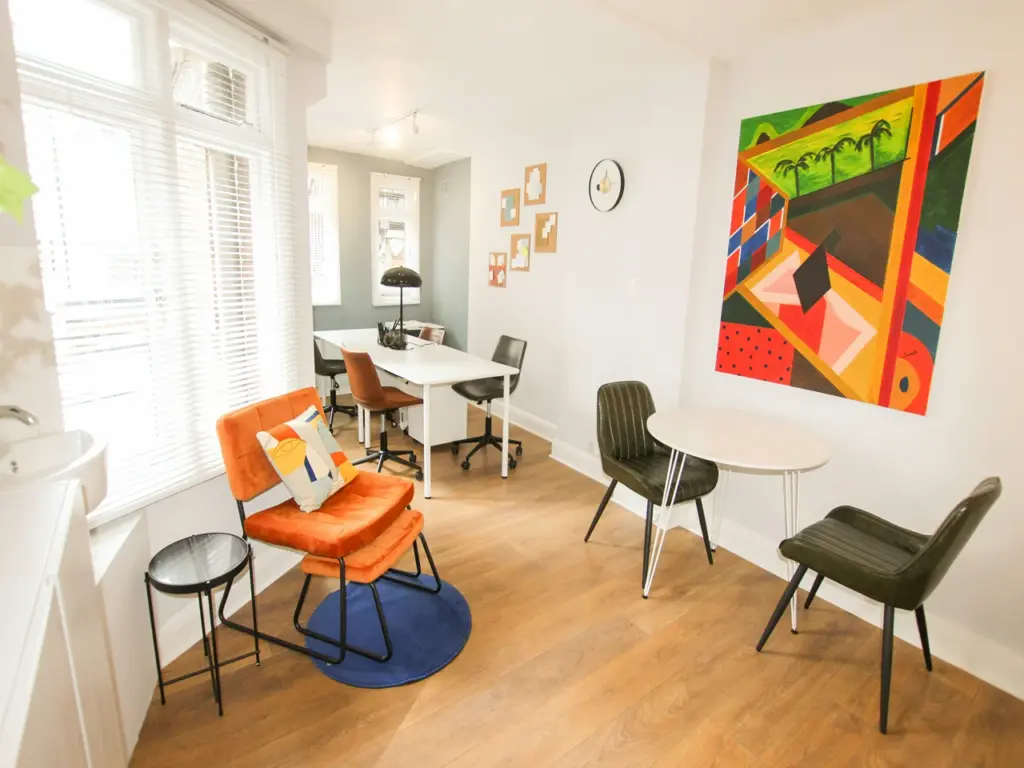
Traffic Flow Planning
Efficient traffic flow is essential to keeping your office space both organized and accessible. Ensure pathways are clear of clutter, allowing easy movement whether you’re working solo or accommodating informal meeting spaces. A well-planned layout helps maintain a seamless workflow and avoids disruptions during busy work hours.
Natural Lighting Considerations
A workspace flooded with natural light can boost productivity, improve focus, and uplift your mood. Place your desk and chair near windows to take full advantage of daylight, enhancing the atmosphere with sheer window treatments for a softly diffused glow. This not only reduces eye strain but also creates a more inviting and energizing environment.
Zone Designation
Divide your home office into distinct zones tailored for specific activities, such as work, meetings, and storage. Clear design elements, like different furniture arrangements or wall accents, can visually define these spaces. For a new office or design studio, consider including a collaborative work area that promotes teamwork while ensuring individual focus zones remain undisturbed.
Meeting Area Setup
Designate a small but functional space for informal meetings by adding seating options like a sofa or armchair. If your space is limited, a daybed can serve as a versatile addition, functioning as both a comfortable seat and an extra resting spot when needed. Thoughtful seating arrangements make the office feel welcoming and multipurpose.
Equipment Placement
Organize your tools and devices in a way that keeps distractions at bay while ensuring everything you need is within reach. Built-in cabinetry or bookshelves are excellent for storing tech equipment neatly, and maintaining a clean and professional appearance. Prioritize accessibility to create a functional yet visually appealing workspace.
Privacy Considerations
Maintain a focused and productive environment by integrating privacy-enhancing room features. Acoustic panels or a folding screen can block out noise, while rugs not only dampen sound but also add warmth and style to your office. These simple adjustments can significantly enhance your concentration and overall work experience.
Desk Selection and Placement
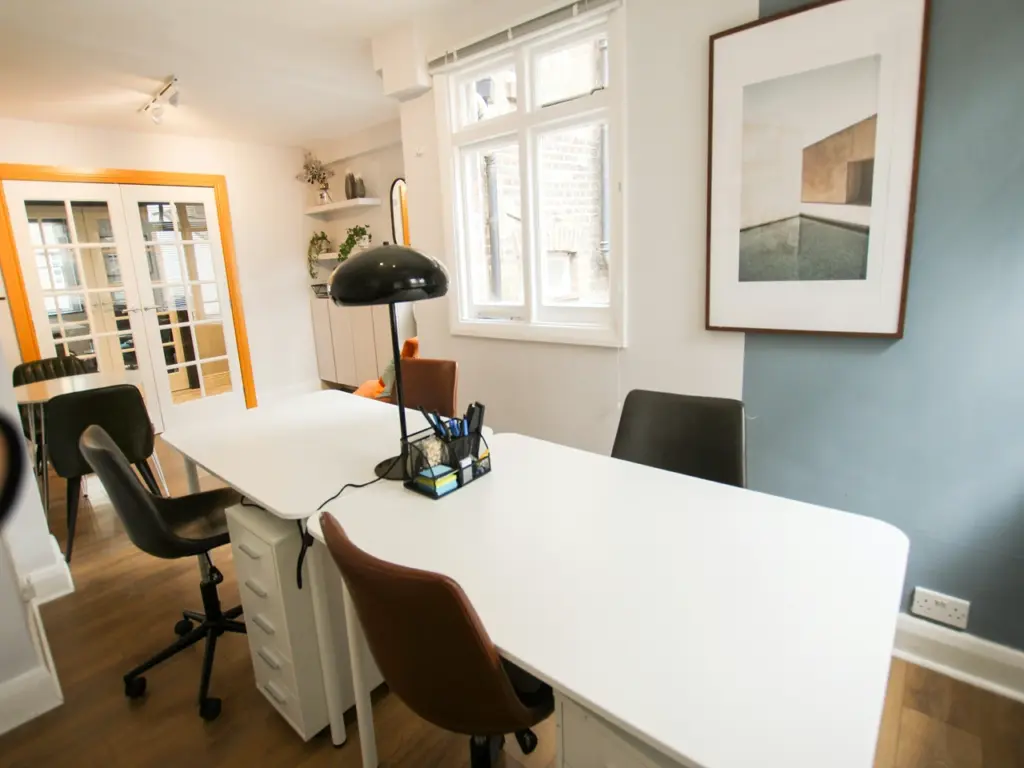
- Ergonomic Measurements: Select a desk with the appropriate height to support good posture and pair it with a swivel chair or ergonomic office chair for maximum comfort. Prioritize adjustable features to accommodate different users and ensure long-term health benefits during extended work hours.
- Material Choices: Whether you prefer the sleek sophistication of glass or the warm charm of wood, choose desk materials that match your office design ideas while ensuring durability. Consider finishes that are easy to maintain and complement the overall aesthetic of your workspace.
- Storage Integration: Enhance functionality by opting for desks with built-in drawers, shelving, or hidden compartments. This combination of style and practicality creates a home office feel where everything you need is within reach yet neatly organized.
- Cable Management: Minimize visual clutter by incorporating concealed cable management systems into your workspace. Thoughtfully designed solutions, such as desk grommets or under-desk organizers, ensure a tidy and distraction-free environment.
- Surface Space Optimization: Choose desks with ample surface area to accommodate your monitors, office accessories, and decorative hardware. A spacious worktop not only provides a clean work area but also allows for flexibility in arranging your workspace to suit your needs.
Office Nook Solutions
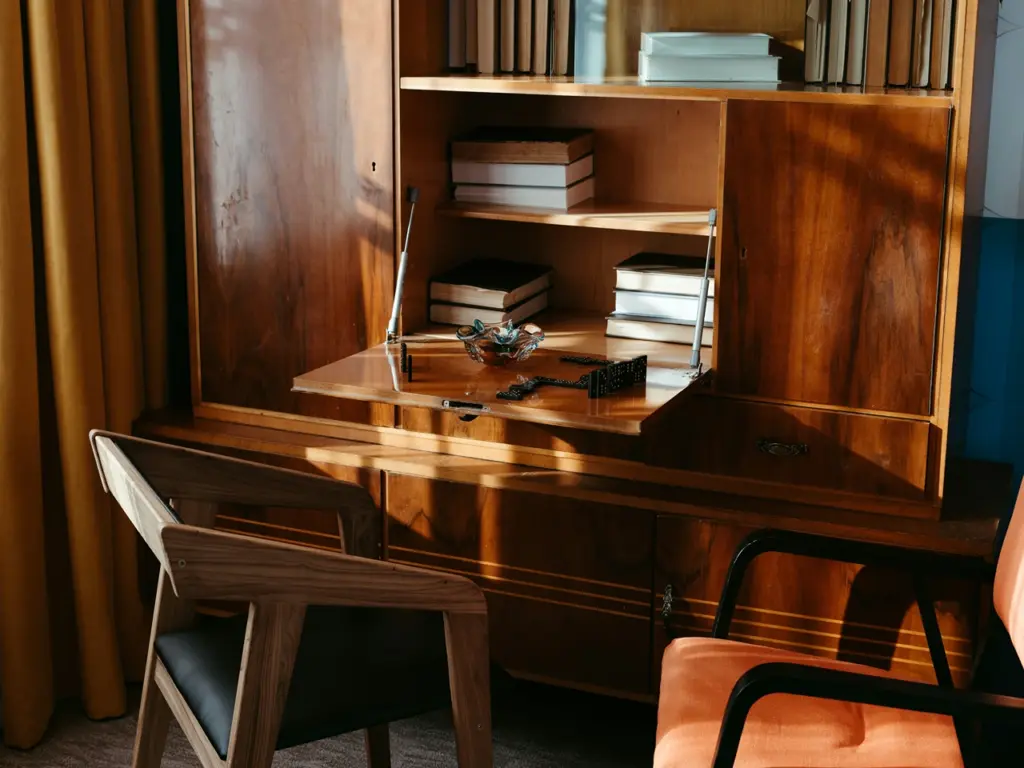
- Space-Saving Strategies: Transform your small office into a functional haven with thoughtful furnishing choices. You may opt for wall-mounted desks to free up floor space and consider compact, multipurpose solutions like a daybed that serves as both a guest room staple and extra seating. Explore creative ideas to make every corner of your space work harder for you without compromising on comfort.
- Vertical Storage Options: Maximize your work area by utilizing bookshelves and tall cabinetry. These vertical storage solutions not only save space but also help keep your office organized and clutter-free, making it easier to focus on productivity.
- Fold-Down Furniture: For a more dynamic setup, incorporate fold-down desks or secretary desks that can be easily stowed away when not in use. These pieces are perfect for small offices where flexibility is key to maintaining a functional space.
- Hidden Storage Solutions: Add a touch of practicality and style with hidden storage options like ottomans or benches with concealed compartments. These pieces seamlessly blend functionality and design, offering discreet storage for a cleaner, more organized environment.
- Multifunctional Elements: Enhance your office nook with furniture that serves multiple purposes. A dining table can double as a workstation, making it a versatile choice for small spaces. This approach ensures every piece in your office contributes to both aesthetics and functionality.
Inspiring Office Design Ideas
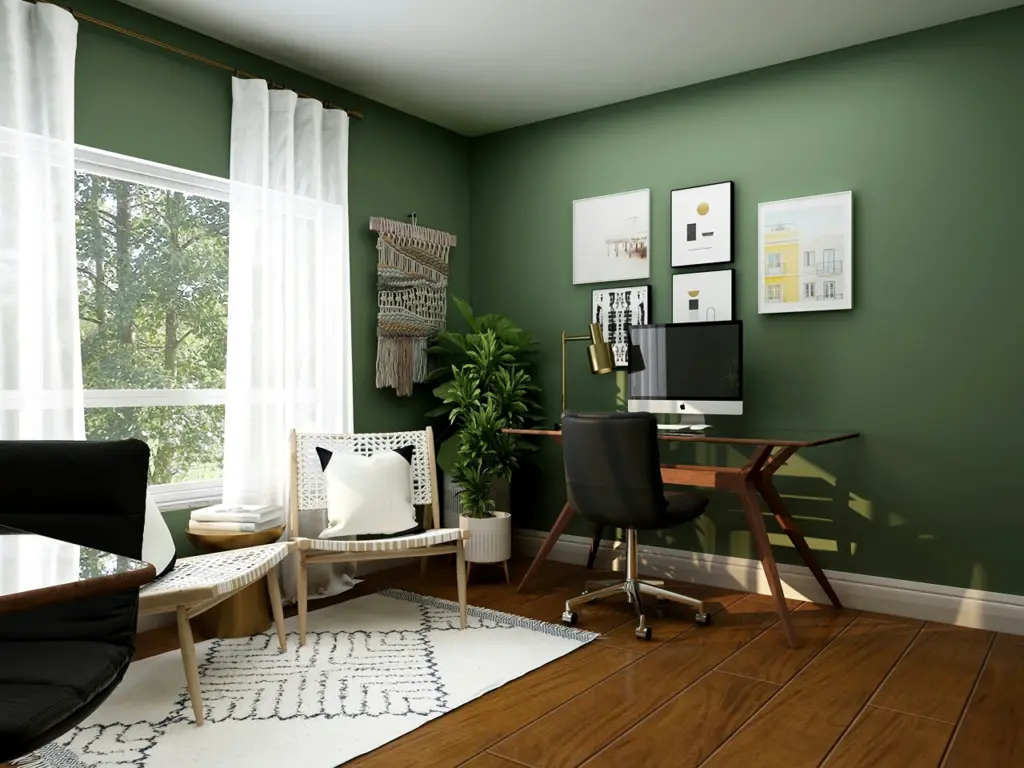
- Colour Psychology: Boost productivity by incorporating colours that influence mood and focus. Blues create a calm and focused environment, while yellows bring energy and positivity. Decorate the space with pops of colour against clean white walls to maintain a light and bright home office atmosphere that feels both refreshing and energizing.
- Biophilic Integration: Bring the outdoors in with natural accents like potted plants, hanging greenery, or even vertical gardens. These elements not only beautify your home office area but also improve air quality and create a calming, nature-inspired workspace.
- Lighting Layers: Use a combination of pendant lighting, task lamps, and ambient lighting to achieve a functional yet visually appealing office setup. Proper lighting enhances focus and reduces eye strain, creating a space where productivity thrives throughout the day.
- Texture Combinations: Add depth and personality to your office interiors by mixing patterns and materials such as warm wood, sleek metal, and soft fabrics. These contrasting textures make the space visually interesting while maintaining a professional yet comfortable vibe.
- Architectural Features: Emphasize unique elements like floor-to-ceiling windows that flood your workspace with natural light or exposed beams that add character. These architectural touches make your home office feel personalized and stylish while supporting a productive and inspiring environment.
Creative Office Organization

- Filing Systems: Opt for stylish filing cabinets or wall-mounted file holders that not only keep your documents organized but also enhance the aesthetics of your workspace. Label folders clearly to make finding files quick and hassle-free.
- Digital Storage Solutions: Transition to a paperless system by utilizing cloud-based tools like Google Drive or Dropbox for secure and efficient file management. Regularly back up your data to ensure everything stays safe and easily retrievable.
- Workflow Optimization: Design your workspace to support a natural workflow by placing tools and equipment in a logical order. For example, keep your printer, notepad, and pens close to where you handle paperwork to save time and energy.
- Tool Accessibility: Use desktop organizers or drawer dividers to keep frequently used items like pens, sticky notes, and chargers within arm’s reach. This ensures you stay focused and avoid unnecessary distractions while working.
- Supply Management: Maintain a clutter-free environment by storing extra office supplies like paper, stationery, and cables in designated storage boxes or drawers. Regularly check and replenish your stock to avoid last-minute rushes.
Pattern and Accent Implementation
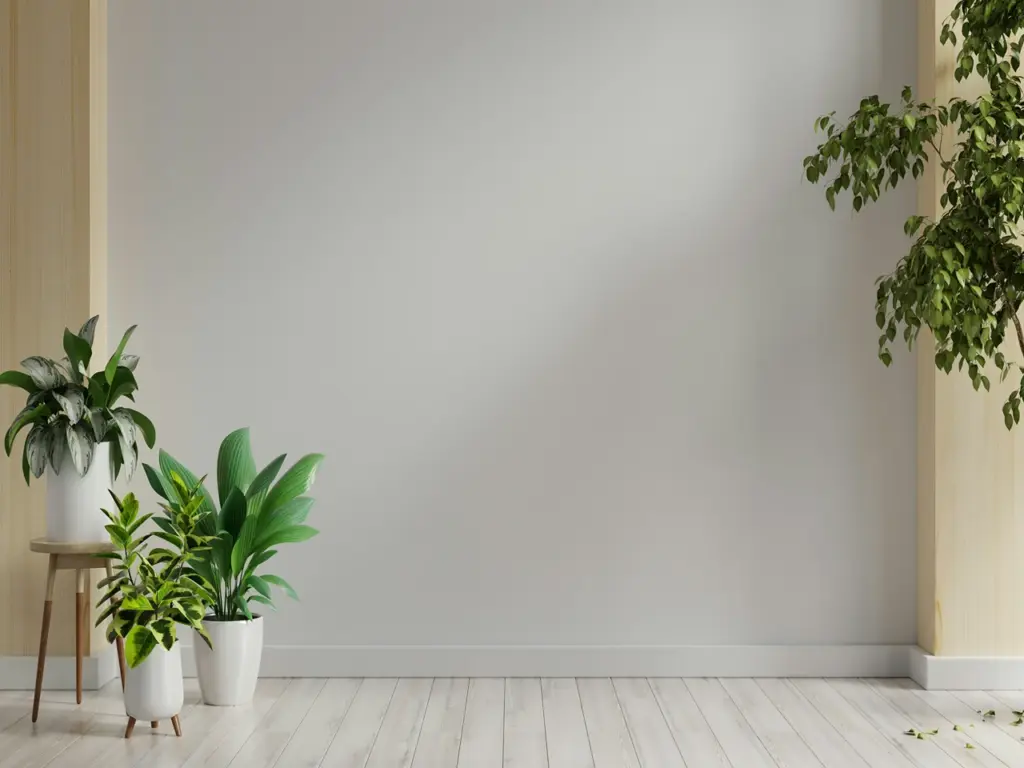
- Wall Treatments: Transform your workspace with bold-patterned wallpaper or create a focal point using an accent wall. These design elements add texture and personality, setting the tone for a more inspiring environment.
- Textile Selections: Elevate the coziness of your office by incorporating soft throws, decorative cushions, and curvy rugs. These additions not only make the space more inviting but also break the rigidity of traditional office designs.
- Floor Coverings: Define specific zones or bring warmth to all-white spaces with stylish area rugs. They serve as both a functional and decorative element, enhancing the overall aesthetic of your workspace.
- Window Treatments: Choose curtains or blinds that align with your design aesthetic while offering control over light and privacy. Opt for patterns or textures that seamlessly integrate into the overall theme of the room.
- Decorative Hardware: Infuse personality into your home office with unique drawer pulls, curtain rods, or other small hardware details. These subtle accents can make a big difference in transforming a generic workspace into one that feels truly your own.
Gallery Wall Composition
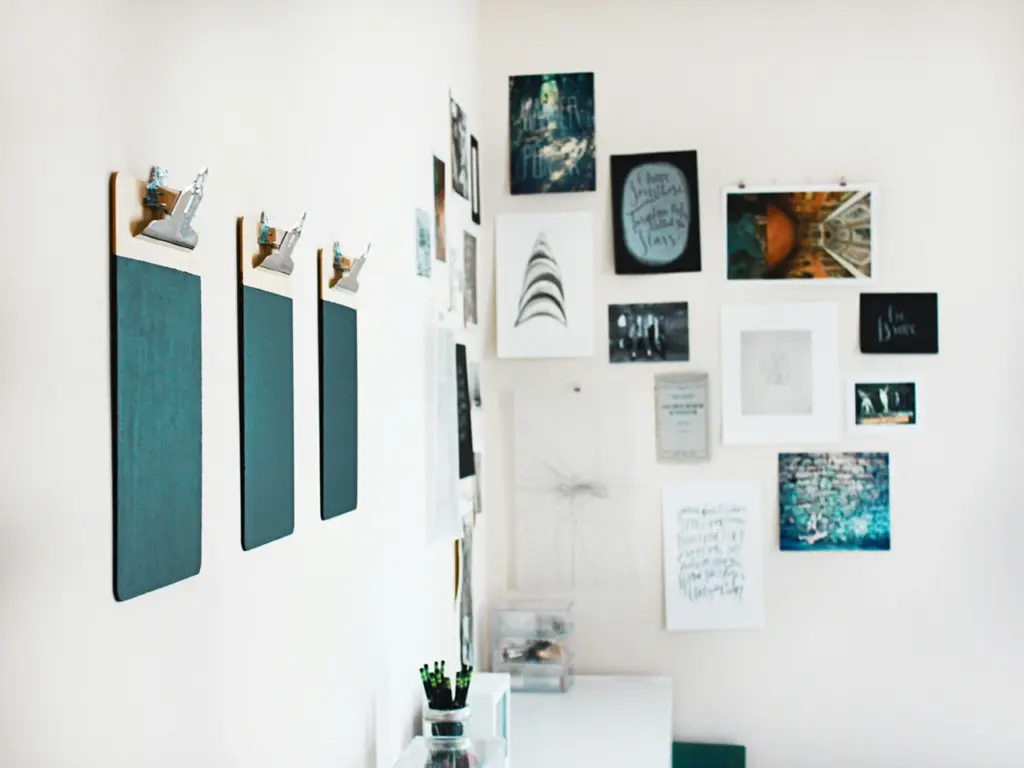
- Art Selection: Carefully curate artwork that resonates with your personality and sparks creativity. Choose pieces that align with your personal style, whether it’s modern, vintage, or abstract, to create a gallery wall that feels uniquely yours.
- Layout Planning: Design a visually appealing arrangement by experimenting with frames of varying sizes and orientations. A balanced layout will ensure your gallery wall looks intentional and polished, serving as a striking focal point in the room.
- Frame Coordination: Decide whether to match frames for a sleek and cohesive appearance or mix different styles for an eclectic and dynamic vibe. The right choice of frames can enhance the overall aesthetic of your gallery wall.
- Personal Elements: Add a personal touch by incorporating family photos, souvenirs, or other meaningful items. These elements make the gallery wall feel more intimate and reflective of your story.
- Visual Balance: Achieve harmony by carefully balancing colours, textures, and spacing across the wall. A well-proportioned design ensures the gallery wall remains inviting and visually pleasing without feeling overcrowded.
Workstation Ergonomics
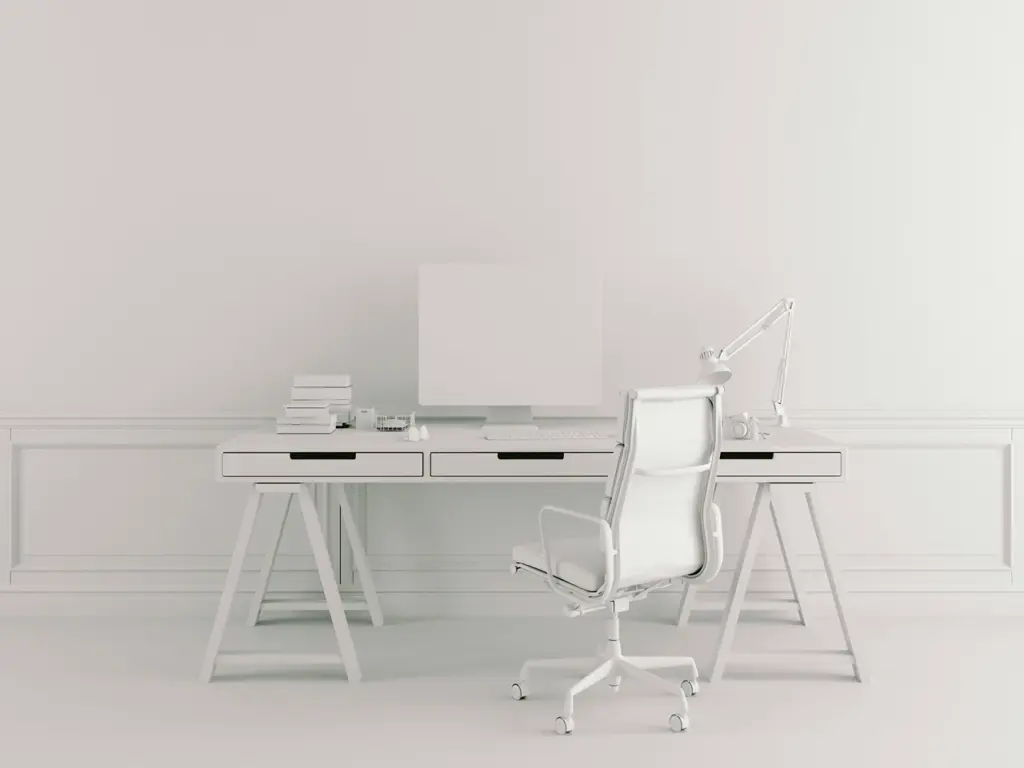
- Chair Selection: Choosing the right chair is essential for maintaining comfort and reducing strain during long work hours. Invest in an ergonomic swivel chair or an adjustable desk chair that supports your back, promotes good posture, and allows for easy movement. This ensures your seating adapts to your workplace design and minimizes physical discomfort.
- Monitor Positioning: Proper monitor placement is key to avoiding neck strain and eye fatigue. Place your monitors at eye level, ensuring the top of the screen aligns with your line of sight. This small adjustment can make a big difference in maintaining productivity and overall comfort.
- Keyboard Placement: To protect your wrists and improve your typing posture, use a keyboard tray or position your keyboard at elbow height. This setup promotes proper wrist alignment, reducing the risk of strain or repetitive stress injuries during extended use.
- Foot Support: Adding a footrest to your workstation provides additional support and comfort, especially during long work sessions. It helps improve circulation and reduces pressure on your lower back, complementing an ergonomic workplace design.
- Standing Options: Incorporating a standing desk or a height-adjustable converter brings flexibility to your workspace. Alternating between sitting and standing throughout the day not only improves posture but also enhances energy levels and overall productivity.
Home Office Space Elements To Inspire Productivity
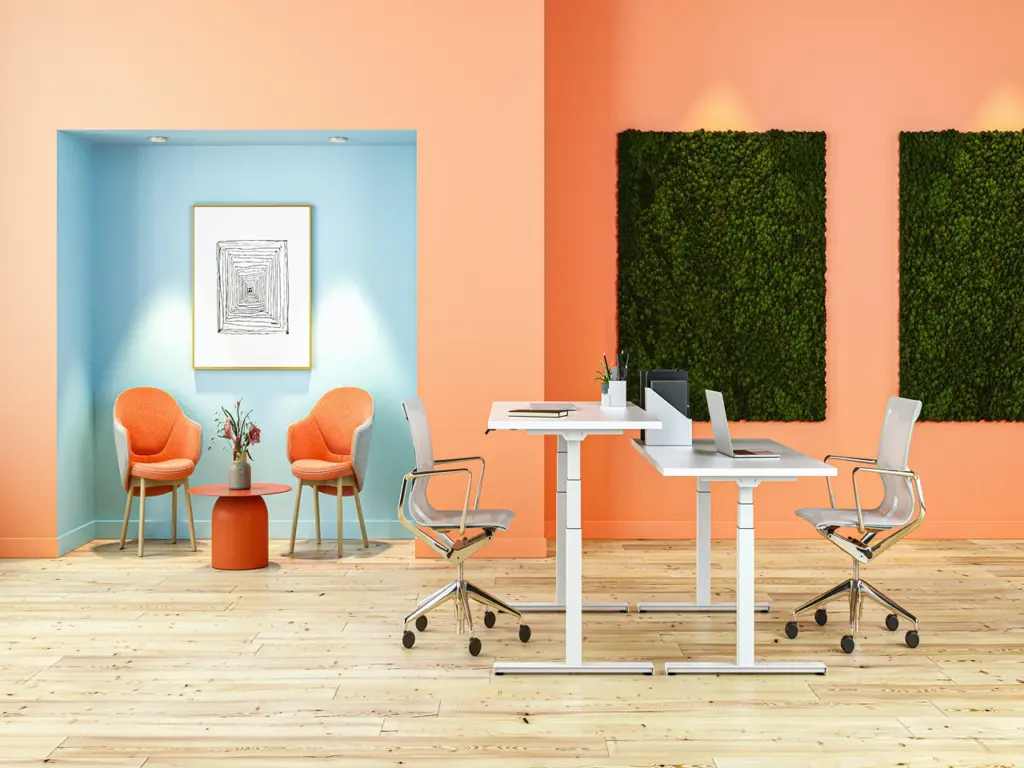
- Technology Integration: Equip your home office with smart tools like adjustable lighting and voice-controlled assistants to create a seamless and efficient workspace. These technologies not only enhance convenience but also allow you to customize your environment for different tasks, ensuring optimal focus throughout the day.
- Time Management Tools: Incorporate tools like wall clocks or digital productivity apps to help you stay on track with your schedule. Visual reminders and timers can serve as gentle nudges to maintain momentum and effectively manage your time.
- Focus Enhancement: Design your home office to minimize distractions with noise-cancelling headphones or soundproofing elements. Setting up a dedicated focus zone, away from high-traffic areas, ensures that you can fully immerse yourself in your work.
- Break Area Design: Include a comfortable sofa or armchair in a separate part of your home office to create a space for short breaks. This dedicated relaxation zone helps you recharge and return to work with renewed energy and focus.
- Wellness Incorporation: Enhance your home office by adding elements that support physical and mental well-being, such as ergonomic standing mats, greenery, or indoor plants. These additions create a more inviting and healthier work environment, promoting both comfort and productivity.
Final Thoughts
Designing an office that balances functionality, comfort, and aesthetics can significantly boost your productivity and creativity. From optimizing lighting and traffic flow to incorporating ergonomic furniture and personalized decor, every element plays a vital role in creating a workspace that works for you. Whether you’re designing a modern office design or a cozy office nook, the right interior design can boost productivity and make your in-office or work from home experience truly enjoyable.
By incorporating these home office design ideas, you can transform your work area into a space that inspires and supports your goals. Overall, demanding the expertise of interior designers and exploring creative office design ideas can help elevate the functionality and aesthetics of your space.
Frequently Asked Questions
What are the top design trends for creating the best office ideas?
Functional Minimalism: Embrace clean lines and clutter-free spaces, focusing on practical office furniture that enhances productivity while keeping the workspace modern and sleek.
Biophilic Integration: Incorporate greenery and natural materials to create a calming, nature-inspired workspace that improves air quality and boosts focus.
Multi-Zone Layouts: Divide your entire room into zones for work, relaxation, and storage, ensuring each area supports different aspects of productivity.
Smart Technology: Add smart lighting and automated tools to streamline daily tasks and personalize your workspace with ease.
Textural Contrast: Use a mix of textures like wood, metal, and soft fabrics to create depth and personality in your home office design.
What are the best home office layout tips for a productive workspace?
Traffic Flow Optimization: Ensure clear pathways for movement to keep the workspace accessible and reduce disruptions during work.
Natural Light Positioning: Place your desk near a window to take full advantage of natural light for better mood and focus.
Dedicated Zones: Designate specific areas for work, storage, and informal meetings to maximize the functionality of your entire room.
Ergonomic Setup: Position your desk and chair to support good posture and make work comfortable for extended hours.
Vertical Storage: Use tall bookshelves and wall-mounted cabinets to save space while keeping your office organized.
How can office furniture enhance your home office decorating ideas?
Multifunctional Pieces: Invest in dual-purpose furniture like a daybed or convertible desk to maximize utility in smaller spaces.
Ergonomic Options: Choose chairs and desks with adjustable features to ensure long-term comfort and efficiency.
Stylish Storage: Incorporate built-in cabinets or hidden compartments to maintain a clean and visually appealing workspace.
Statement Pieces: Add a bold desk or unique chair to infuse personality into your home office while anchoring the design theme.
Portable Furniture: Consider lightweight, movable items to allow flexibility in reconfiguring your home office layout as needed.
How can you personalize your workspace and add personality to your home office?
Artwork Displays: Curate a gallery wall featuring personal art or inspirational quotes to make the space uniquely yours.
Decorative Accents: Incorporate cushions, rugs, or hardware details that reflect your personal style.
Colour Psychology: Choose colours like blues or yellows to set the mood—whether calming or energizing—for your workspace.
Custom Lighting: Use pendant lights, task lamps, or string lights to create a workspace ambiance that suits your preferences
What are the best home office decorating ideas for transforming an entire room?
Bold Wall Treatments: Use patterned wallpaper or create an accent wall to set the tone for a vibrant and inspiring environment.
Layered Lighting: Combine ambient, task, and accent lighting to enhance the room’s functionality and aesthetic appeal.
Functional Flooring: Incorporate area rugs to define work zones while adding warmth and style to the office.
Architectural Features: Highlight unique elements like exposed beams or large windows to elevate the room’s character.
Organized Layouts: Implement a cohesive design by ensuring all furniture and decor align with the overall aesthetic of the space.
